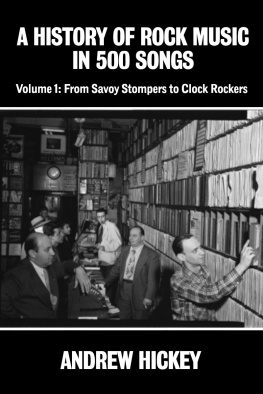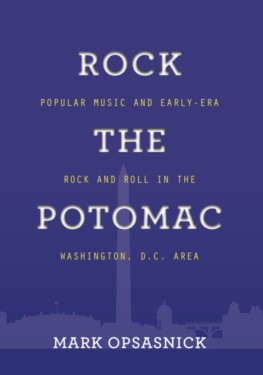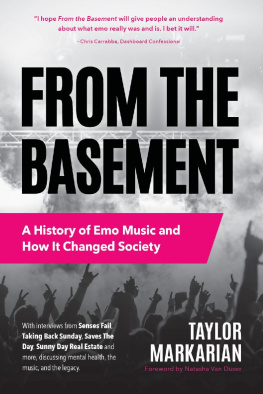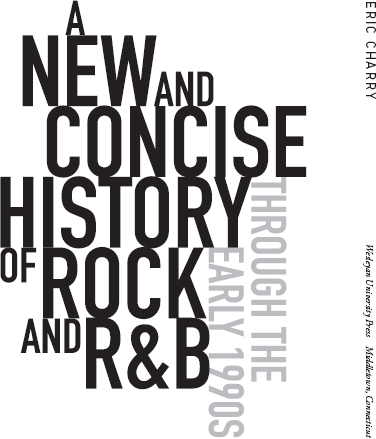
A NEW AND CONCISE HISTORY OF ROCK AND R&B THROUGH THE EARLY 1990s
Wesleyan University Press
Middletown, CT 06459
www.wesleyan.edu/wespress
2020 Eric Charry
All rights reserved
Manufactured in the United States of America
Designed by Mindy Basinger Hill
Typeset in 11/15pt Garamond Premier Pro
Library of Congress Cataloging-in-Publication Data
Names: Charry, Eric S., author.
Title: A new and concise history of rock and R&B through the early 1990s / Eric Charry.
Description: [First.] | Middletown : Wesleyan University Press, 2020. | Includes bibliographical references and index. | Summary: This book about rock and R&B lays out key theoretical issues, covers the technical foundations of the music industry, and provides a capsule history of who did what when, with particular emphasis on the rapid emergence of distinct genresProvided by publisher.
Identifiers: LCCN 2019053822 (print) | LCCN 2019053823 (ebook) | ISBN 9780819578952 (trade paperback) | ISBN 9780819578969 (ebook)
Subjects: LCSH: Rock musicHistory and criticism. | Rhythm and blues musicHistory and criticism.
Classification: LCC ML3534 .C454 2020 (print) | LCC ML3534 (ebook) | DDC 781.6409dc23
LC record available at https://lccn.loc.gov/2019053822
LC ebook record available at https://lccn.loc.gov/2019053823
5 4 3 2 1
CONTENTS
LIST OF FIGURES
ACKNOWLEDGMENTS
I thank all the students who passed through my course MUSC108 (History of Rock and R&B) at Wesleyan University, especially those who raised questions or were not shy about pointing out rookie errors. Their many hundreds of creative class projects (audio and video recordings and magazine articles) provided myself, themselves, and their peers Im sure, with great entertainment and insight, with some song cover versions and rewrites surpassing the originals. Adult students in Wesleyans Graduate Liberal Studies Program and at the Cheshire Correctional Institution also provided valuable feedback on versions of this manuscript. The latter students were especially open about questioning what they read, and I thank them for their candor and directness. I thank John Bergeron, Noah Baerman, and my teaching assistants for their help with MUSC108.
My colleagues in the Music Department at Wesleyan University have provided a warm and inspiring environment, which has contributed greatly to my thinking about music. I thank Priya Charry for formatting all the figures; Suzanna Tamminen, director of Wesleyan University Press, for seeing this project through to completion; and the two anonymous peer reviewers, whose critical comments were invaluable in formulating revisions. I thank Dan for our many-decades-long conversation about the music covered here and, as always, Hannah, Priya, and Miriam for their support and for just being there.
INTRODUCTION
This book offers a concise history of rock and R&B (rhythm and blues) through the early 1990s in three parts. explores key contemporary theoretical issues, with concrete examples that provide frames of reference for processing and interpreting the material in the first two parts. Throughout, I draw extensively on primary sourcesthe voices of musicians, writers, and consumers (using chart data) at the time.
This particular combination of approaches and methods offers a new perspective, and herein lies the uniqueness of this text. The sixty-four figures each tell a story, and the accompanying writing fleshes them out. The figures are intended to guide readers through a diverse, unwieldy, and seemingly anarchic field of musical expression. A crucial point to ponder with most of the figures is why these elements are put together on a single page. In other words, what do the artists, groups, genres, songs, albums, or record labels have in common? This gets to the heart of how a genre or style congeals.
With the increasing availability of quality online content, readers should be well prepared to move deeper into the stories; understand historical flows and ruptures; recognize innovations, overarching trends, and genre formations; critically evaluate an artists or groups place within a genre; critique my own selection process; and, most important, listen. Most sections contain footnotes with specialized lists of additional print, film, and video resources.
A New and Concise History stops in the early 1990s for several reasons. It developed out of notes for an undergraduate course I have been teaching annually since 2002, and so it is keyed to what can reasonably be packed into a single college semester. As a text for a one-semester course, it already contains a dense amount of material for a sustained, intensive, and holistic experience. Those finishing this book should be well prepared to explore on their own more recent music, the reception and perception of which is in a greater state of flux. Furthermore, those born in the 1990s and later may have a more intimate and visceral relationship to music of the past several decades. Putting that music under a micro- (and macro-) scope, with a veneer of academic objectivity, runs a risk of diminishing returns. The historical distance with the subject matter in the following pages may help readers embrace a greater breadth of perspective on more recent music.
Throughout this book I adopt the spirit in which twenty-two-year-old Muhammad Ali referred to singer Sam Cooke as he made his way into the ring to congratulate Ali the night he won the world heavyweight boxing championship in February 1964. Cooke had been a star of the gospel music world before crossing over to the secular world of R&B, pop, and soul, a style that he personifiedthe previous year Cooke released an album titled Mr. Soul. Amid the celebration and a television interview, Ali called out, This is Sam Cooke! Let Sam in. This is the worlds greatest rock n roll singer (qtd. in Guralnick 2005: 55859). I often use the terms rock and roll and rock as shorthand to cover the fullest conglomeration of many loosely connected genres and subgenres. A narrower usage of the term rock in the popular press can refer to an aesthetic tied to the 1960s and 1970s, exemplified in a predominantly white, guitar, bass, and drums format.
Some prefatory notes will help the reader more quickly grasp the information presented. All song titles are in quotations marks; album titles are in italics. I often refer to Billboard magazine popularity chart positions (sales, radio airplay), and so it is crucial to understand their significance. Popularity does not necessarily equate with artistic merit. High chart positions primarily indicate that an artist or group is being widely heard (in homes on record, cassette, or CD players and on the radio) and most likely appreciated. (There is a valid argument that record labels and radio stations can collude, and have done so, to successfully push undeserving artists.) When the month and year of a record (and sometimes full date) is provided, it refers to its initial entry into a chart (unless otherwise noted). This marks its entry into the public consciousness, which could be right after its release or many months later. In cases where a record appeared in several charts with different entry dates, I occasionally opt (in the disco and electronic dance music sections) to indicate the month of entering the first chart and list the charts by chronological date of entry (e.g., entered charts October 1974: dance #1, pop #9, R&B #34). This enables the crossover path to be seen without too much clutter.
Next page













